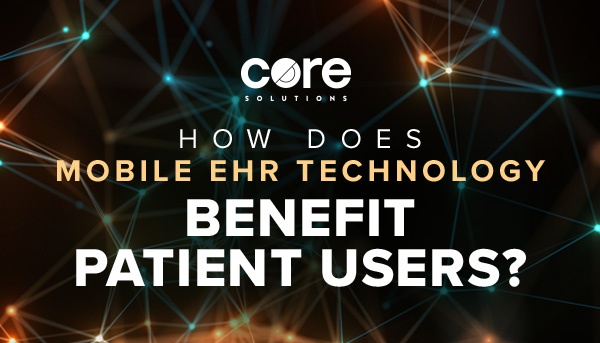OPEN MINDS Recap: Connecting the Dots from Data to Value
by Core Solutions on June 28, 2017

At the latest OPEN MINDS Strategy & Innovation Institute, Core Solutions President Ravi Ganesan led an informative session on the strategic use of data in the healthcare industry. Along with co-presenter Adam Bauer, Senior Manager at Deloitte, Ravi spoke about the importance of establishing effective data collection and evaluation processes to better support today’s healthcare organizations. In this blog post, we’ll review some of the biggest takeaways from the presentation entitled “Connecting the Dots from Data to Value.”
Embracing Innovation: The Digital Transformation Framework
A recent survey of over 600 businesses worldwide found that 72% of executives consider their organization susceptible to digital market disruption. In another survey, 60% of healthcare organizations admit to expecting disruption by digital technology. These obstacles can come in the form of new or improved insights, data and analytics. The critical importance of embracing technology and innovation in healthcare organizations is at its highest level today. Healthcare leaders must encourage the use of technology in supporting data collection and knowledge-sharing experiences in order to grow their organization, prepare for change, compete in the industry and better serve their customers. A tool called the Digital Transformation Framework can help in mapping out what your organization should do to embrace digital innovation.
The Role of IoT in Deciphering Automated Data
Understanding the concept of The Internet of Things (IoT) is required in order to participate in the evolution of its use in the healthcare industry. How IoT fits into the Internet Ecosystem dictates its unique role in collecting and deciphering automated data. For healthcare professionals and their patients, IoT can be used in countless ways to supplement or improve care delivery. Sample use cases include fall detection for the elderly, location-tracking for loved ones, heart attack prevention and disease monitoring. Whatever the intended use, it’s best to follow this simple set of guidelines for implementing IoT in your business: start small, show viability and prove value.
Evidence-Based Clinical Tools for Demonstrating Data Value
It’s not enough to recognize the significance of collecting data and growing a data driven organization; it’s also critical that you invest in the right tools to build and demonstrate the value brought by these initiatives. In behavioral health services, tools used should support measurement-based care through rating scales administration. Clinical tools for outcome measurement should clearly reflect the added value of data collected. This is where visual presentation also comes into play.
Visual Perception & the 6 Principles of Analytical Design
The way we visually perceive data contributes to our overall understanding of the data itself; a concept best implemented using the foundational principles of design. Because of the way our eyes and minds “think,” communicating data should be done using visual displays of information. A great tool to use in presenting data that resonates with your audience is Edward Tufte’s set of six foundational principles of analytical design. Using these principles help to better contextualize and analyze important facts and figures that carry the potential to translate into new innovations and efficiencies.
Many healthcare and human services organizations have difficulty forming an actionable plan to begin and finish their journey to digital transformation and the meaningful use of data. With these takeaways in mind however, organizations can start to leverage a powerful asset to improve many aspects of the healthcare ecosystem.
If you missed this engaging OPEN MINDS session, view the accompanying slide deck to get a closer look at everything that was discussed.
- April 2024 (3)
- March 2024 (4)
- February 2024 (1)
- October 2023 (3)
- September 2023 (3)
- August 2023 (2)
- June 2023 (2)
- May 2023 (3)
- April 2023 (4)
- March 2023 (2)
- November 2022 (3)
- October 2022 (1)
- September 2022 (1)
- August 2022 (3)
- July 2022 (1)
- June 2022 (1)
- January 2022 (2)
- December 2021 (1)
- October 2021 (2)
- September 2021 (2)
- August 2021 (2)
- July 2021 (5)
- June 2021 (5)
- March 2021 (2)
- January 2020 (3)
- November 2019 (3)
- October 2019 (2)
- July 2019 (1)
- June 2019 (1)
- May 2019 (1)
- April 2019 (3)
- October 2018 (1)
- September 2018 (1)
- August 2018 (1)
- July 2018 (1)
- June 2018 (1)
- May 2018 (2)
- April 2018 (1)
- March 2018 (1)
- December 2017 (1)
- October 2017 (2)
- September 2017 (1)
- June 2017 (2)
- May 2017 (2)
- April 2017 (1)
- February 2017 (2)
- January 2017 (3)
- November 2016 (2)
- October 2016 (3)
- September 2016 (2)
- August 2016 (1)
- July 2016 (2)
- June 2016 (1)
- May 2016 (3)
- April 2016 (2)
- March 2016 (2)
- February 2016 (2)
- January 2016 (3)
- December 2015 (2)
- November 2015 (4)
- October 2015 (3)
- September 2015 (4)
- August 2015 (1)


Let us know what you think